Dubai is known as a city of opportunity.
As the second-largest emirate and one of the world’s fastest-growing and most diverse economies, it has attracted a thriving population.
In 2025, Dubai is the most populated emirate in the UAE, with an estimated 3.90 million residents.
Dubai Population 2025 (Key Statistics)
According to Dubai Statistics Center, the population of Dubai as of April 2025 is 3.90 million
The total male population of Dubai in 2025 is 2.63 Million
The total female population of Dubai in 2025 is 1.21 Million
According to calculations by the GMI Research Team, Dubai has the highest population percentage in the age group 25-54, adding up to 2.65 million
The expatriate population in Dubai in 2025 accounts to 92.02%, that is, 3.53 million
Dubai’s sector 3 has the highest percentage population among the 9 sectors, coming to 1.4 million
Dubai Population Statistics 2025 (Infographics)

Copy and paste this code to embed the infographic on your website.
Dubai Population Prediction
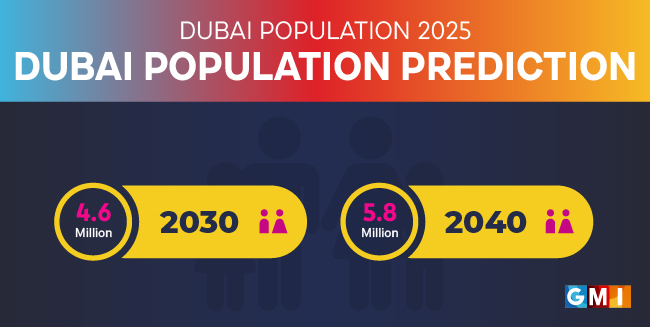
Since the start of the year 2024 to mid-October 2024, Dubai’s population has seen an increase of over 134,000 people, says a report by global ratings agency S&P.
With the growing economy and the thriving job market, people find Dubai the right place to settle in.
Expo 2020 and Dubai’s emergence as a major international-quality tourism destination have brought more attention to the place, further fueling the influx of people.
By 2030, the population of Dubai is expected to hit a whopping 4.6 million.
And by 2040, the population is predicted to reach 5.8 million.
Dubai Overview
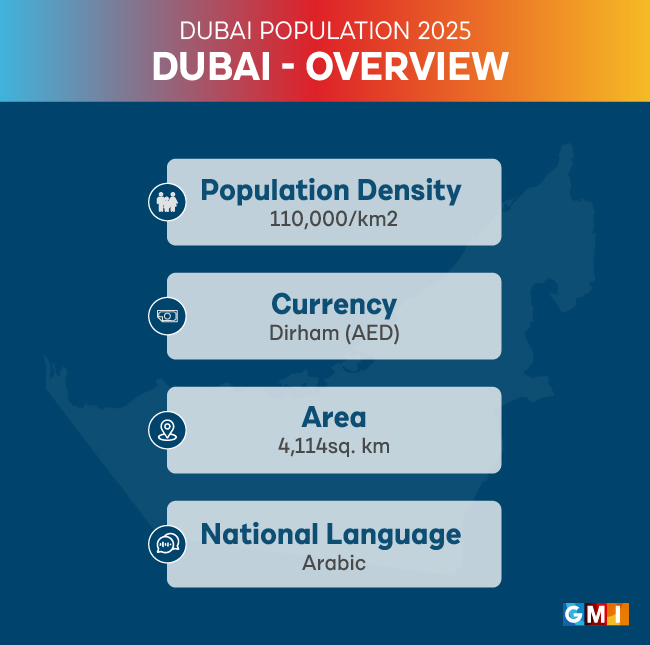
Dubai is one of the seven emirates that make up the UAE.
It shares borders with Abu Dhabi in the south, Sharjah in the northeast, and the Sultanate of Oman in the southeast.
The emirate spans an area of 1,588 sq mi (4,110 km2) and has a population density of 110,000/km2.
The national language of Dubai is Arabic although English is also widely spoken and used in business, tourism, education, and daily communication.
The national currency of Dubai is UAE Dirham (AED).
From a desert trading port to a global metropolis, Dubai has seen rapid transformation.
The city has grown as a centre for regional and international trade since the 20th century.
Dubai’s economy mainly relies on tourism, trade, real estate and finance services.
Dubai Demographics in 2025
Dubai’s demographics reflect a diverse and dynamic society.
In the following sections, we explore the key aspects that define Dubai’s population structure.
Gender Split of Dubai Population
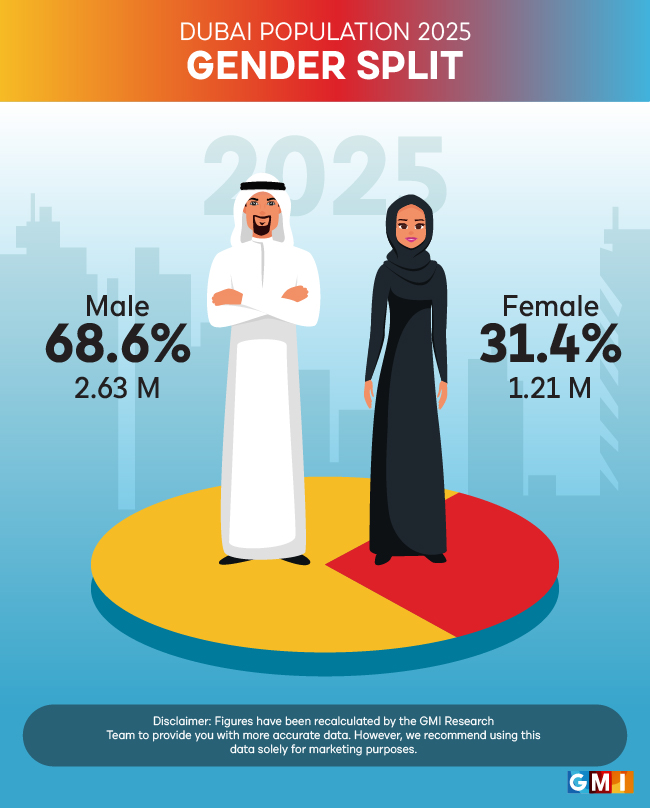
The gender split of the population of Dubai shows that there is a higher proportion of male compared to females (218 male for 100 female).
68.6% of Dubai’s population are male which corresponds to 2.63 million people.
The female population falls at 1.21 million, that is 31.4% of the total population.
The disparity in the male-female ratio is mainly due to external workers who come for jobs without their family members.
It is interesting to note that when looking at the gender split at a household level, the male-female ratio is balanced, showing a healthy equilibrium.
Gender | Population | Population (%) |
Male | 2.63 Million | 68.60% |
Female | 1.21 Million | 31.40% |
📌 Note: Figures have been recalculated by the GMI Research Team to provide you with more accurate data. However, we recommend using this data solely for marketing purposes.
Dubai Population by Age
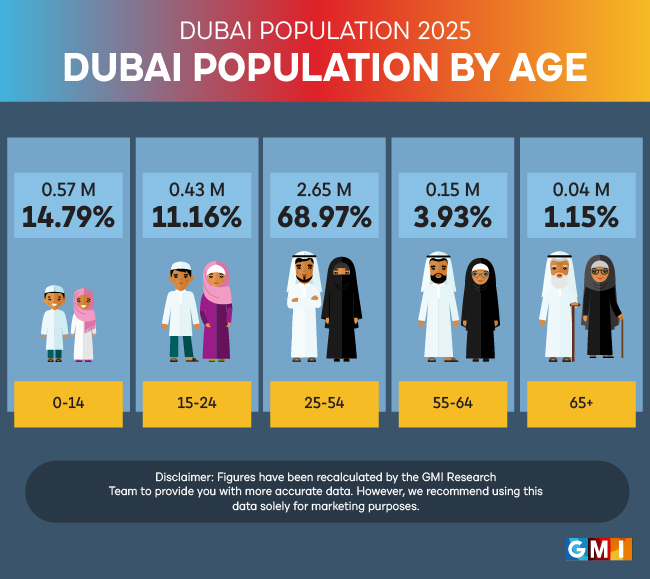
Since Dubai is a commercial hub, the majority of the population belongs to the prime working age group, i.e. individuals in the age group of 25 – 54.
14.79% of the population of Dubai belongs to the 0-14 age group. This is the second largest age group, totalling to 0.57 million people.
Compared to the 0-14 age group, the 15-24 years age group has a slightly smaller population, accounting to 11.16% or 0.43 million.
The highest percentage population is constituted by the 25-54 age group. They make up 68.97% of the population, approximately 2.65 million – nearly three-quarters of the total population of Dubai.
The population percentage significantly drops when it comes to the older age groups.
The 55-64 years age group constitutes only 3.93%, ie, 0.15 million people.
And the 65+ years age group accounts for an even smaller share, totalling to 1.15%, around 0.04 million.
Age Group | Population | Population (%) |
0-14 years | 0.57 Million | 14.79% |
15-24 years | 0.43 Million | 11.16% |
25-54 years | 2.65 Million | 68.97% |
55-64 years | 0.15 Million | 3.93% |
65 years and above | 0.04 Million | 1.15% |
📌 Note: Figures have been recalculated by the GMI Research Team to provide you with more accurate data. However, we recommend using this data solely for marketing purposes.
Dubai Population by Gender
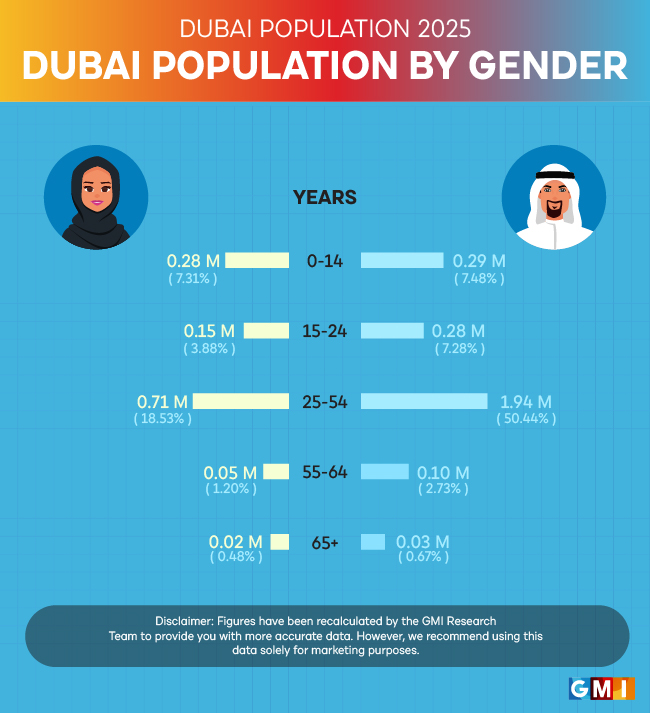
To take a deeper look into the Dubai population by age, we calculated the population by gender for the different age groups.
In all age groups, the population of men is higher than that of women, with the 25-54 age group having the highest population percentage and 65+ age group having the lowest population percentage.
In the 0-14 age group, 7.48% (0.29 million) was constituted by men while 7.31% (0.28 million) were women.
This near equality in the men-women percentage drops for the other age groups.
Looking at the 15-24 age group, we can see a sharp decline in the women population.
While the men’s population constitutes 7.28% (0.28 million), the women’s population accounts for only 3.88% (0.15 million).
The 25-54 years age group follows a similar trend with 50.44% (1.94 million) being men and only 18.53% (0.71 million) being women.
Coming to the older age groups, the 55-64 year age group also has a higher men population, accounting to 2.73% (0.10 million).
The women population for the 55-64 group is 1.20% (0.05 million).
For the 65 years and above group, the population split by gender is nearly balanced with 0.67% (0.03 million) being men and 0.48% (0.02 million) being women.
Age Group | Men | Women |
0-14 years | 0.29 Million | 0.28 Million |
15-24 years | 0.28 Million | 0.15 Million |
25-54 years | 1.94 Million | 0.71 Million |
55-64 years | 0.10 Million | 0.05 Million |
65 years and above | 0.03 Million | 0.02 Million |
📌 Note: Figures have been recalculated by the GMI Research Team to provide you with more accurate data. However, we recommend using this data solely for marketing purposes.
Emirati vs Expatriate Population in Dubai
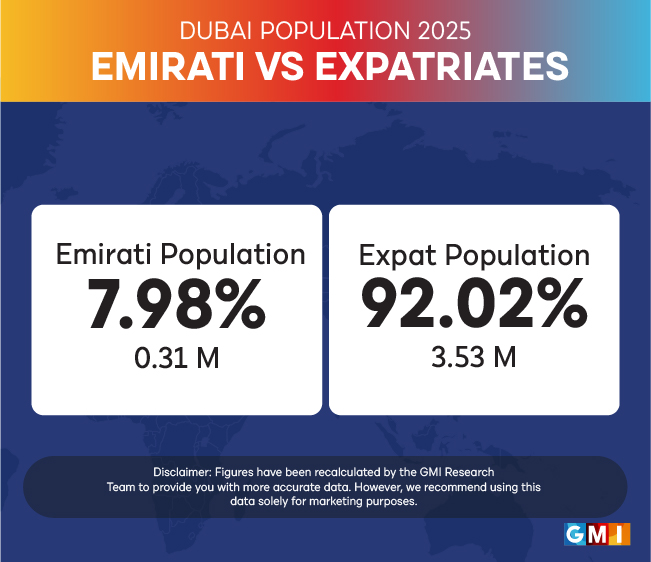
Dubai has one of the highest expatriate populations in the world.
The reason for the huge expatriate population is
Economic growth and job opportunities which attract professionals from all over the world
The safety and high quality of life
The strategic location with well-connected airports
Investor and business friendly policies encouraging long-term residencies
The large scale infrastructure and development projects creating ongoing employment opportunities
The expatriate residents make up 92.02% of the population of Dubai, which corresponds to 3.53 million.
The Emirati population, on the other hand, accounts to 7.98%, approximately 0.31 million people.
Nationality | Population | Population (%) |
Emirati | 0.31 Million | 7.98% |
Expatriate | 3.53 Million | 92.02% |
📌 Note: Figures have been recalculated by the GMI Research Team to provide you with more accurate data. However, we recommend using this data solely for marketing purposes.
Population Distribution in Dubai by Planning Sector
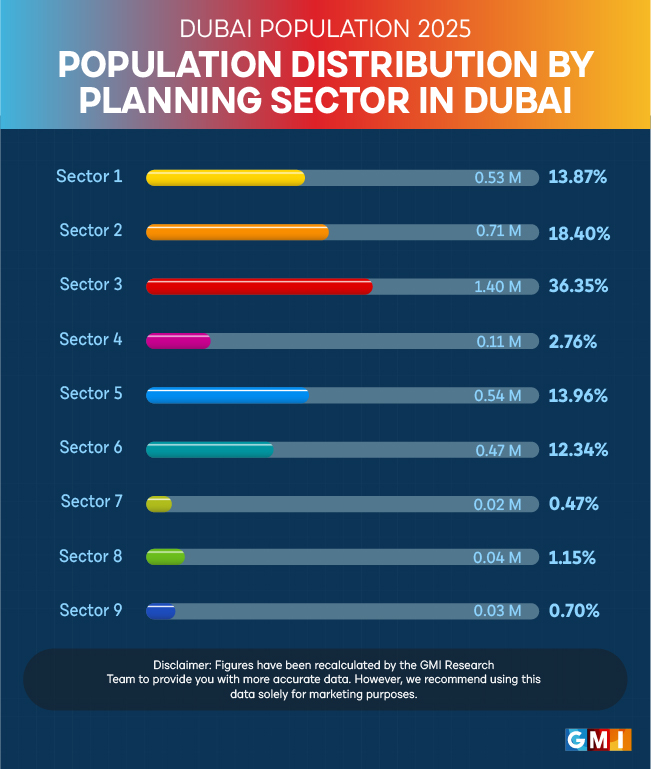
The Emirate of Dubai is divided into 9 sectors based on the administrative boundaries. Sectors 1-6 are primarily urban areas and include the majority of the populated areas.
Sectors 7-9 are considered more rural. Each sector is further divided into smaller communities or subdistricts.
Sector 1 – Northern coastal area of Dubai on the north bank of Dubai Creek, corresponding to the district Deira
Sector 2 – Northern area of Dubai on the border with the Emirate of Sharjah, including including Muhaisnah, Mirdif, Al Nahda and Al Qusais
Sector 3 – Along the central coastal area of Dubai, and on the southern bank of Dubai Creek, including Bur Dubai, Jumeirah, and their immediate outlands
Sector 4 – Central-northern area of Dubai, including Ras Al Khor, Nad Al Hammar and Al Warqaa
Sector 5 – Southern coastal area of Dubai, from Marsa Dubai in the north, to the border with the Emirate of Abu Dhabi in the south, including Jebel Ali
Sector 6 – Central area of the Emirate of Dubai including the vast industrial area of Ras Al Khor, the residential areas of Nad Al Sheba and Wadi Al Safa, with the Al Warsan area containing the residential complex of Dubai International City
Sector 7 – North-eastern part of the Emirate of Dubai, bordered to the north and east by the Emirate of Sharjah
Sector 8 – Central-eastern area of the Emirate of Dubai, sharing border to the east with the Emirate of Sharjah and to the south with the Emirate of Abu Dhabi
Sector 9 – central and southern area of the Emirate of Dubai, bordered to the south and west by the Emirate of Abu Dhabi
Sector 3 has the highest population concentration representing 36.35% of the total population, totaling 1.40 million residents.
Sector 2 and Sector 5 have the second and third highest population respectively, comprising 18.4% (0.71 million) and 13.96% (0.54 million) of the total population.
Sector 1 stands at a close fourth position, with 13.87% (0.53 million people).
Sector 6 is the next highest populated sector, with 12.34% of the population, that is 0.47 million people.
Sectors 4, 7, 8 and 9 are comparatively less populated.
Sector 7 is the least populated sector, with only 0.47% of the total population.
Sector 9 is also sparsely populated, accounting to 0.70% (0.03 million).
Sector 8 and Sector 4 have slightly higher populations, comprising 1.15% (0.04 million) and 2.76% (0.11 million) respectively.
Sector | Percentage | Population (in Million) |
Sector 1 | 13.87% | 0.53 M |
Sector 2 | 18.40% | 0.71 M |
Sector 3 | 36.35% | 1.40 M |
Sector 4 | 2.76% | 0.11 M |
Sector 5 | 13.96% | 0.54 M |
Sector 6 | 12.34% | 0.47 M |
Sector 7 | 0.47% | 0.02 M |
Sector 8 | 1.15% | 0.04 M |
Sector 9 | 0.70% | 0.03 M |
📌 Note: Figures have been recalculated by the GMI Research Team to provide you with more accurate data. However, we recommend using this data solely for marketing purposes.
Dubai Population by Year
Over the past five decades, Dubai has experienced remarkable population growth, transforming from a modest trading port into a bustling global metropolis.
In 1975, the city’s population was 183187 (0.18 million).
In 2025, the population stands at 3,907,733 (3.90 million), marking a significant increase.
Looking at the 50 years in between, the population has consistently been on the rise.
In 1980, the population rose to 276,301 (0.28 million) and by 1985, it was 370,788 (0.37 million).
By 1995, the population crossed half million, amounting to 689,420 (0.69 million).
During the period, the growth was driven by the discovery of oil, infrastructural development, and the rise of trade and tourism.
From then, the population growth saw a sharper rise, more than doubling from 862,387 in 2000 to 1.91 million in 2010.
It was a period of rapid urban expansion.
Projects like Burj Khalifa and Palm Jumeirah were taking shape, attracting global attention.
Dubai was also establishing free zones at this time, boosting foreign investment and expatriate population.
The population rose from 1.91 million in 2010 to 3.41 million in 2020, marking a nearly 80% increase in a decade and crossing 3 million.
During this time, Dubai had begun to diversify its economy, focusing on sectors like tourism, finance, and real estate.
In 2023, Dubai housed 3,655,000 (3.66 million people).
It rose to 3,790,000 (3.79 million) in 2024 and stands at 3,907,733 (3.90 million) at present.
The introduction of long term residency programs and remote work policies make Dubai a preferred destination for expatriates, continuing to attract them to the country.
| Year |
Population |
2025 | 3.90 Million |
2024 | 3.79 Million |
| 2023 | 3.66 Million |
| 2020 | 3.41 Million |
| 2015 | 2.45 Million |
| 2010 | 1.91 Million |
| 2005 | 1.32 Million |
| 2000 | 0.86 Million |
| 1995 | 0.69 Million |
| 1985 | 0.37 Million |
| 1980 | 0.28 Million |
| 1975 | 0.18 Million |
The Future of Dubai’s Population Growth
Dubai’s population growth has been driven by rapid urbanization, economic expansion, and an influx of expatriates from around the world.
A reflection of its ambitious vision, the city is transforming into an international hub.
With a strong foundation in infrastructure, innovation, and investment-friendly policies, Dubai is poised for continued growth in the coming years.
As Dubai continues to grow, strategic planning and adaptability will be key to ensuring that its population growth contributes positively to the growth of the UAE.
⚠️ Disclaimer: GMI acknowledges that while we strive for accuracy, we cannot verify the absolute facts of everything represented in this Article. The information presented is based on research from various online sources. Additionally, some figures have been recalculated by the GMI research team based on the previous year’s percentages. We are not liable for any errors, financial loss, or damages of any kind resulting from the use of or reliance on this information.

GMI’s Research Team is a panel of knowledgeable experts from various fields such as digital marketing, social media, and web development, all united by a common goal—to educate. We enjoy exploring everything from the latest industry trends and emerging technologies to people and demographics, both in the UAE and beyond. Through our blog posts, we share valuable insights that help businesses and marketers stay informed and prepared for the challenges and opportunities that lie ahead.









